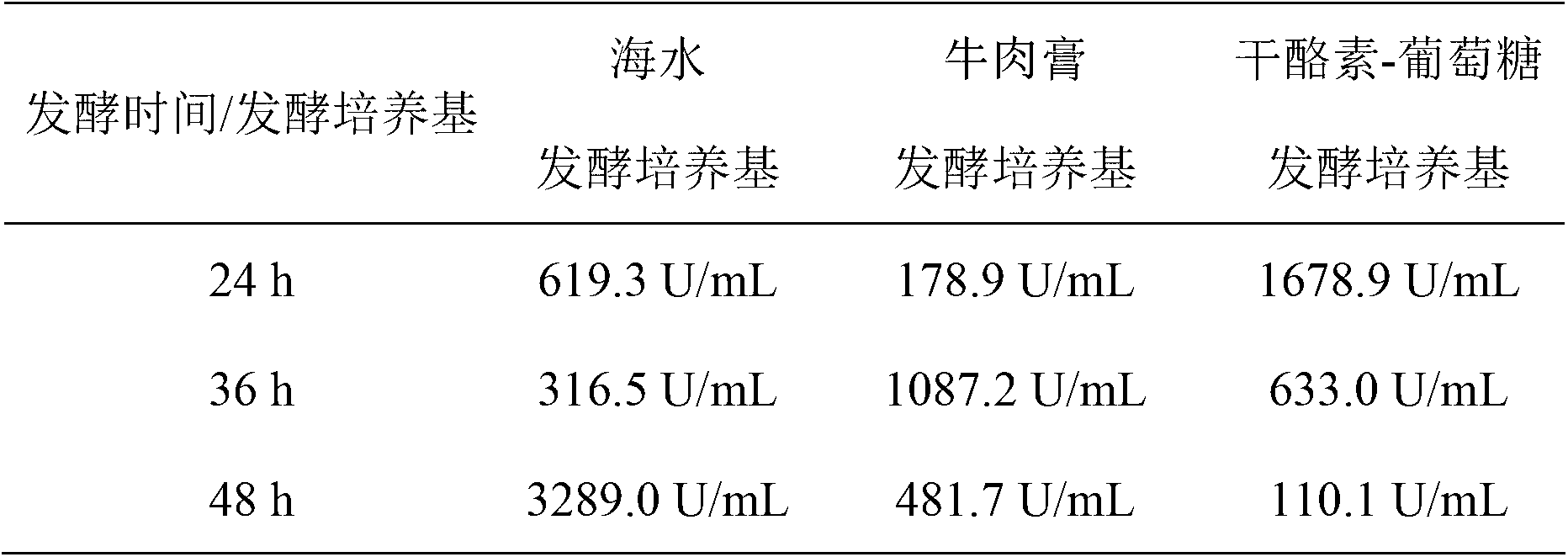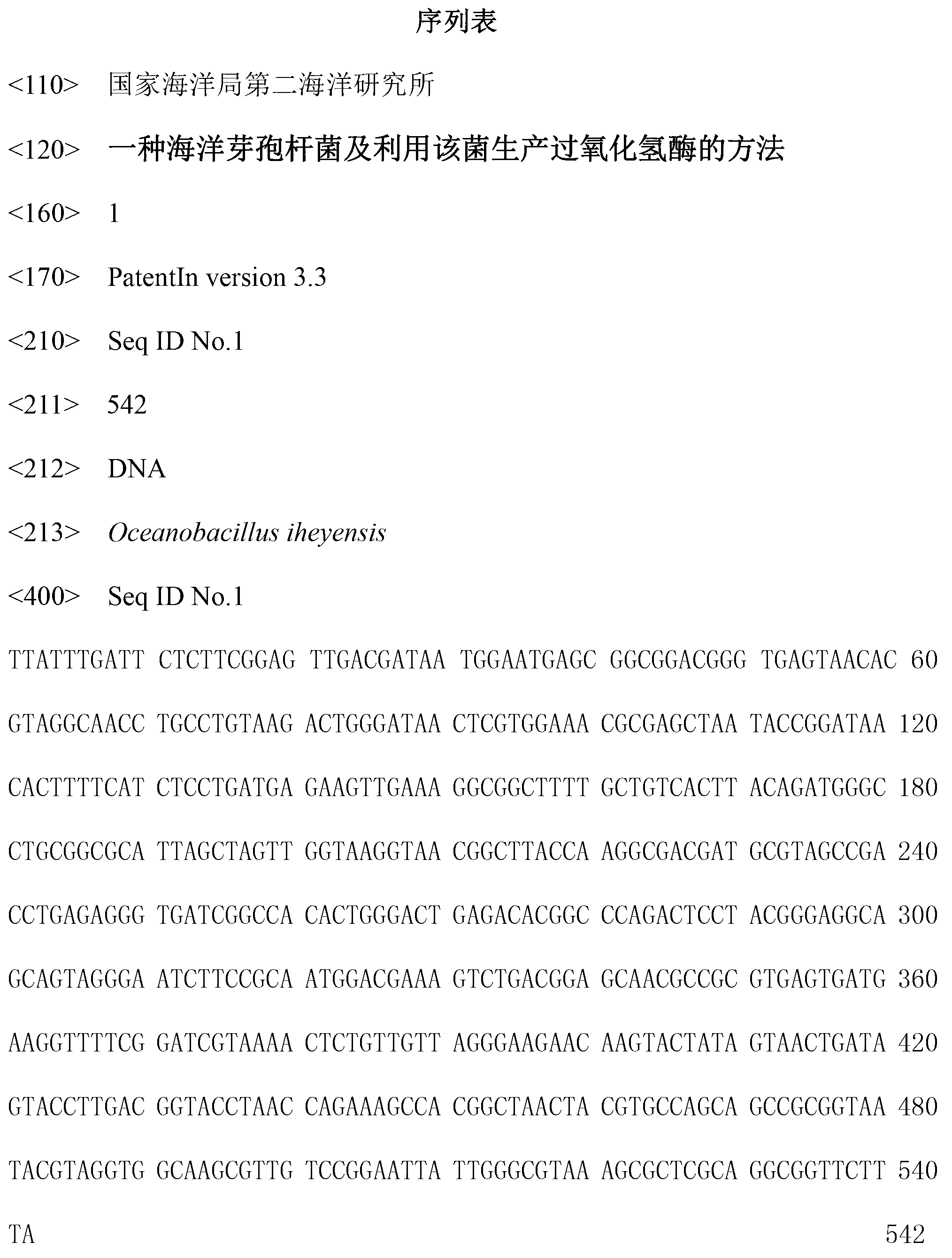Bacillus marinus and method for producing catalase by using same
The technology of marine bacillus and catalase is applied in the field of marine bioengineering and achieves the effects of low cost, simple preparation process, and improved expression and activity
- Summary
- Abstract
- Description
- Claims
- Application Information
AI Technical Summary
Problems solved by technology
Method used
Image
Examples
Embodiment 1
[0024] Example 1 Isolation and screening of Iheyensis marine bacillus (O.iheyensis) CGMCC No.6042
[0025] Use NaOH or HCl to fine-tune the pH of 4.5mL natural seawater to 7.2, add 0.75% (w / v) agar and sterilize at 121°C for 20 minutes. Sterilize 4 μL of 30% hydrogen peroxide, mix well, cool and solidify to make seawater semi-solid medium. Under sterile conditions, add 4.5mL of collected seawater samples to the seawater semi-solid medium, as well as filter-sterilized carbon and nitrogen sources, and the final concentration (w / v) is peptone 0.25%, yeast extract 0.01% and casamino acids 0.25%. Shake enrichment culture at 28°C for about 4 days, dilute the enrichment solution to an appropriate multiple and spread it on a plate, pick a single clone and store it on a slant.
[0026] The bacterial strain isolated by the above method is transferred to natural seawater liquid medium for shake flask fermentation, and the catalase activity re-screening is carried out by spectrophotomet...
Embodiment 2
[0029] Example 2 Morphological identification and biological characteristics of Iheyensis marine bacillus (O.iheyensis) CGMCC No.6042
[0030] Iheya Ridge Marine Bacillus (O.iheyensis) CGMCC No.6042 was inoculated in natural seawater liquid medium, and 20g / L agar could be added to prepare solid medium. After cultivation, it was identified that the bacteria has the following characteristics: (1) Colony morphology: the colony is round, with smooth surface, flat edges, slightly raised, milky white; (2) Cell morphology: Gram-positive bacteria, under the cell microscope (Olympus, BX40) exhibits motility and is rod-shaped; (3) Physiological and biochemical characteristics: aerobic growth; oxidase positive; hydrolysis of escin, Tween 40 or Tween 60, non-hydrolysis of Tween 80, DNA or Urea; does not produce indole; can use glucose, mannose, fructose or maltose to produce acid, but cannot use arabinose or rhamnose to produce acid; to amoxicillin, ampicillin, chloramphenicol, erythromyc...
Embodiment 3
[0031] Example 3 PCR Amplification and Sequencing of the 16S rRNA Gene of O.iheyensis CGMCC No.6042
[0032] Inoculate O.iheyensis marine bacillus (O.iheyensis) CGMCC No.6042 in natural seawater solid medium, pick a ring of bacteria directly from the slope, add 200 μL of sterile water to fully suspend the bacteria, and bathe in water at 100°C for 30 minutes , centrifuged at 12000rpm for 2 minutes and immediately ice-bathed, and the supernatant was used as a template for PCR. A pair of universal primers for amplifying the 16S rRNA gene are as follows:
[0033] Forward primer: 5'-AGAGTTTGATCCTGGCTCAG-3';
[0034] Reverse primer: 5'-GGTTACCTTGTTACGACTT-3';
[0035] The above primers respectively correspond to bases 8-27 and bases 1510-1492 of the 16S rRNA gene of Escherichia coli. The PCR reaction system (50 μL) is: 5 μL of 10× buffer, 1 μL of 10 mM dNTPs, 1 μL of each 4 μM primer, 0.5 μL of Taq enzyme, 0.5 μL of template DNA, and 41 μL of sterile pure water. The PCR reaction...
PUM
 Login to View More
Login to View More Abstract
Description
Claims
Application Information
 Login to View More
Login to View More - R&D
- Intellectual Property
- Life Sciences
- Materials
- Tech Scout
- Unparalleled Data Quality
- Higher Quality Content
- 60% Fewer Hallucinations
Browse by: Latest US Patents, China's latest patents, Technical Efficacy Thesaurus, Application Domain, Technology Topic, Popular Technical Reports.
© 2025 PatSnap. All rights reserved.Legal|Privacy policy|Modern Slavery Act Transparency Statement|Sitemap|About US| Contact US: help@patsnap.com


